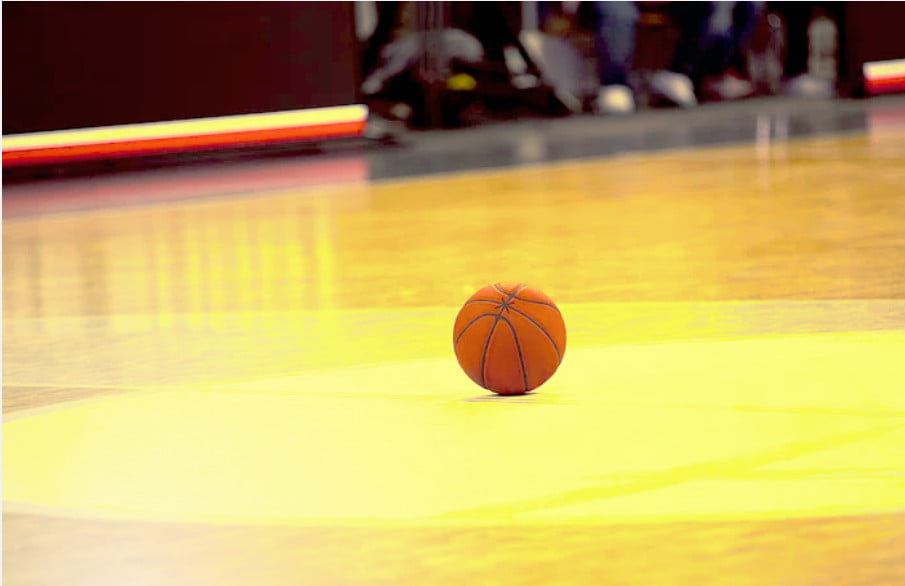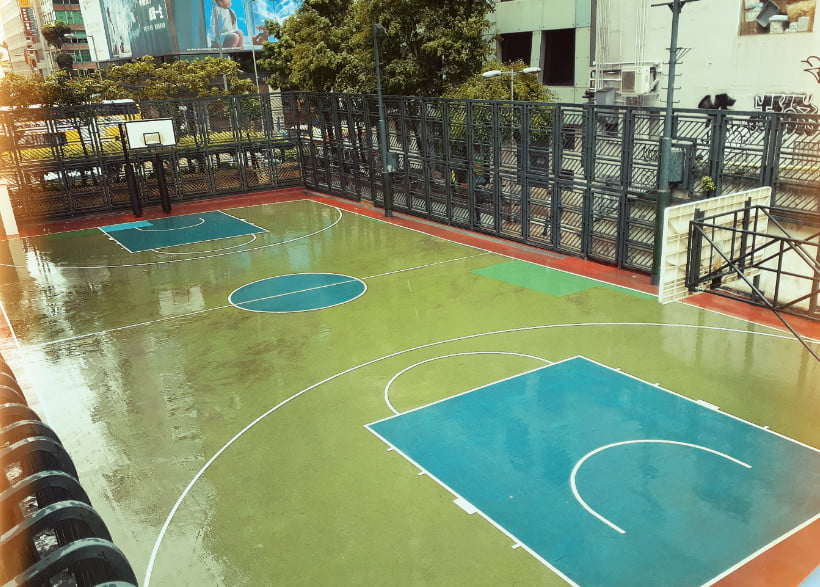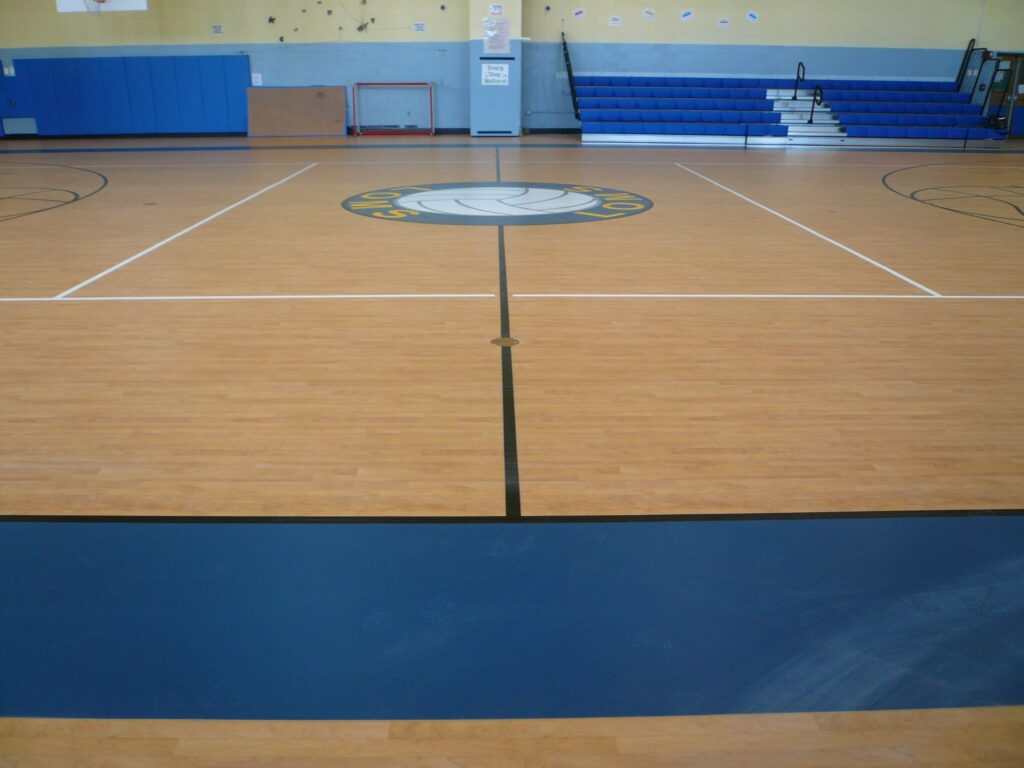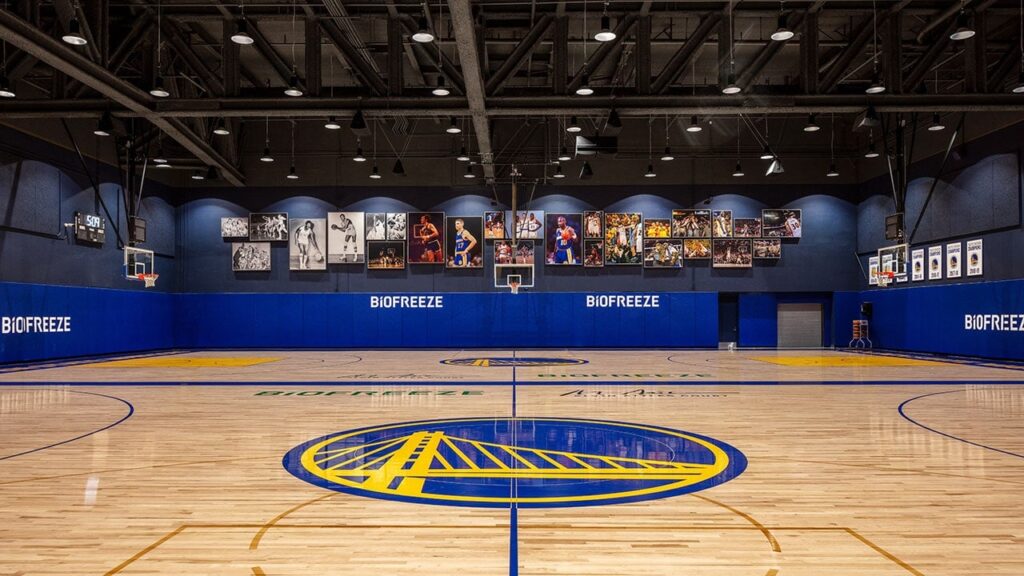Basketball court flooring and what you should know?
Ever wondered why NBA courts look and feel the way they do? If you’re a basketball enthusiast, a school administrator, or someone dreaming of having your own basketball court, you’ve probably pondered this question. The flooring of a basketball court plays a pivotal role in how the game is experienced, from the bounce of the ball to the grip under your sneakers.

In this comprehensive guide, we’ll delve into the world of basketball court flooring, covering everything from key features to consider, types of materials, cost implications, and maintenance tips. Whether you’re looking to install a new court for a school, a professional setting, or personal use, this guide aims to be your go-to resource.
What You’ll Gain from This Guide…
- A deep understanding of the key features that make a basketball court functional and safe.
- Insight into the types of materials available and their pros and cons.
- A clear picture of the cost considerations involved in installing and maintaining a basketball court.
- Practical tips on cleaning and maintenance to extend the lifespan of your court.
The Anatomy of a Basketball Court Floor
When you watch a game of basketball, it’s easy to focus solely on the players and the ball. However, beneath all that action lies a carefully designed surface that significantly impacts the game. Let’s break down the basic components that make up a basketball court floor and how these elements contribute to the overall experience.
Basic Components
- Subfloor: This is the foundational layer that provides stability. It’s usually made of concrete or asphalt for outdoor basketball courts and wood or other materials for indoor courts.
- Surface Material: This is the top layer that players interact with. It can be made from a variety of materials, including wood, rubber, and PVC.
- Paint and Markings: These include the lines for the court boundaries, three-point line, and free-throw line. The paint used must be slip-resistant to ensure player safety.
- Finish: This is a protective layer applied to the surface material. It enhances durability, provides a level of gloss, and can offer additional grip.
How Components Contribute to Experience
- Subfloor: A well-constructed subfloor ensures that the court is level, which is crucial for ball bounce and player movement.
- Surface Material: The type of material used affects several key features like slip resistance, shock absorption, and bounce quality. For instance, wood basketball courts are often preferred for their excellent bounce quality.
- Paint and Markings: Clearly defined and accurate markings are essential for the game’s rules and player strategy.
- Finish: A good finish not only extends the life of the court but also can enhance playability by providing a consistent surface for ball bounce and player traction.
Understanding the anatomy of a basketball court floor is the first step in making informed decisions for your court installation or renovation project. Whether you’re considering an inside basketball court or an outdoor basketball court, each component plays a vital role in how the court will perform.
Key Features to Consider in Basketball Court Flooring

When it comes to choosing the right flooring for your basketball court, several key features come into play. These features not only affect the quality of the game but also the safety and longevity of the court. Let’s delve into these features, so you can make an informed decision.
Durability
A basketball court sees a lot of action, from high-impact jumps to quick lateral movements. Therefore, the flooring material must be durable enough to withstand this wear and tear. Concrete basketball courts and wood basketball courts are often praised for their durability.
Ease of Maintenance
Whether it’s an indoor basketball court or an outdoor basketball court, ease of maintenance is crucial. Some materials are easier to clean and require less frequent maintenance. For example, PVC flooring and rubber basketball court flooring are generally easier to maintain.
Cost-Effectiveness
The initial cost of installing a basketball court can be high, but some materials offer better long-term value. It’s essential to consider both the upfront costs and the long-term maintenance costs.
Aesthetic Appeal
The look of your basketball court can add to the overall experience. Whether you prefer the classic look of a wooden basketball court or the modern appeal of plastic basketball court tiles, aesthetic considerations are important.
Versatility
Some court materials are versatile and can be used for multiple sports. If your court will host not just basketball but also other activities, consider sports court tiles or rubber flooring for their versatility.
Additional Features
- Shock Absorption: Important for player comfort and safety.
- Slip Resistance: Essential for player safety during fast-paced games.
- Fade Resistance: Particularly important for outdoor basketball court flooring.
- Bounce Quality: Affects the game’s pace and player performance.
- Stain Resistance: Makes maintenance easier.
- Climate Suitability: Some materials are better suited for specific climates.
- Material Longevity: How long the material is expected to last.
- Environmental Impact: Consider eco-friendly options for a sustainable choice.
Quick Comparison Table
| Feature | Concrete | Wood | Rubber | PVC |
|---|---|---|---|---|
| Durability | High | High | Medium | Low |
| Maintenance | Low | High | Medium | Low |
| Cost | Medium | High | Low | Medium |
Understanding these key features will help you make an informed decision when choosing the material for your basketball court, whether it’s a residential basketball court or a professional one.
Types of Basketball Court Flooring Materials
Selecting the right material for your basketball court is a critical decision that can significantly impact the game’s quality, safety, and your court’s longevity. Let’s explore the various types of materials commonly used in basketball court flooring.
Concrete Flooring
Concrete is a popular choice for outdoor basketball courts. It’s durable and relatively easy to maintain. However, it can be hard on players’ joints over time. Concrete is also a good base for other types of flooring like rubber basketball court flooring.
Wood Flooring
Wood is the go-to material for indoor basketball courts. It offers excellent bounce and is easier on the joints compared to concrete. However, wood flooring requires regular maintenance and is susceptible to moisture damage. Parquet basketball floors are a luxurious option within this category.
Rubber Flooring
Rubber is a versatile material that can be used both indoors and outdoors. It offers good shock absorption and is slip-resistant. Rubber basketball court flooring is also easier to maintain than wood but may not provide the same professional feel.
PVC Flooring
PVC or vinyl flooring is another option for indoor courts. It’s less expensive than wood and offers good shock absorption. However, it may not be as durable as other materials and can be prone to tearing.
Hard Plastic Flooring
Hard plastic or polypropylene tiles are a good option for outdoor basketball court flooring. These tiles are durable, low-maintenance, and can be easily installed over an existing surface.
Asphalt Flooring
Asphalt is another option for outdoor courts. It’s less expensive than concrete but may require more frequent maintenance. It’s a common choice for backyard basketball courts.
Parquet Flooring
Parquet is a high-end wood flooring option that offers a unique aesthetic. It’s commonly used in professional settings and offers excellent playability but comes at a higher cost.
Innovative Materials
Eco-friendly options like recycled rubber and sustainable wood varieties are also available for those concerned about the environmental impact of their court.
Comparing Material Advantages and Disadvantages
Each material has its pros and cons, and the best choice depends on your specific needs, budget, and location. Here’s a quick comparison table:
| Material | Advantages | Disadvantages |
|---|---|---|
| Concrete | Durable, Low Maintenance | Hard on Joints |
| Wood | Excellent Bounce, Professional Feel | High Maintenance, Costly |
| Rubber | Good Shock Absorption, Versatile | May Lack Professional Feel |
| PVC | Cost-Effective, Good Shock Absorption | Less Durable |
| Asphalt | Cost-Effective for Outdoor Use | Requires More Maintenance |
By understanding the characteristics of each material, you can make an informed decision that suits your specific needs, whether you’re installing a residential basketball court or a professional one.
Cost Analysis of Basketball Court Flooring
When it comes to installing a basketball court, understanding the costs involved is crucial for budgeting and planning. This section will provide a comprehensive breakdown of the expenses you can expect, from the cost per square foot to long-term considerations.
Cost per Square Foot
The cost per square foot varies depending on the material you choose. For instance, concrete basketball court flooring can range from $3 to $7 per square foot, while wood flooring for basketball courts can go as high as $20 per square foot.
Installation Costs
Installation costs can also vary widely. DIY installation can save you money but may require more time and effort. Professional installation, on the other hand, can add significantly to your total cost but ensures quality and durability. For example, basketball court installation costs for a professional setup can range from $3,000 to $30,000 depending on the size and material.
Additional Equipment Costs
Don’t forget the cost of additional equipment like hoops, lighting, and fencing. These can add another $1,000 to $5,000 to your budget.
Total Estimated Costs
Here’s a rough estimate for a standard-size outdoor court:
- Material: $4,000 – $15,000
- Installation: $3,000 – $30,000
- Additional Equipment: $1,000 – $5,000
- Total: $8,000 – $50,000
Long-Term Cost vs. Short-Term Cost
While some materials like asphalt basketball courts may be cheaper initially, they may require more frequent maintenance, adding to the long-term cost. On the other hand, more expensive materials like wood may have lower maintenance costs over time.
Financing Options
Some companies offer financing options to help you spread out the cost of your basketball court project. Make sure to read the terms carefully and consider the interest rates.
Cost-saving Tips
- Opt for multi-use sports court tiles that can be used for different sports.
- Consider cheap outdoor basketball court flooring options like overstock or discontinued lines.
- Look for seasonal discounts or promotions.
By understanding the various costs involved, you can make a more informed decision and choose a basketball court that fits both your needs and your budget.
Installation Process
The installation process of a basketball court is a critical phase that can significantly impact the court’s performance and longevity. Whether you’re considering a DIY project or hiring professionals, this section will guide you through the essential steps and considerations.
DIY vs Professional Installation
The first decision you’ll need to make is whether to go the DIY route or hire professionals. DIY can be a cost-effective option, especially for outdoor basketball court flooring. However, it requires a good understanding of the materials and the process. Professional installation, while more expensive, ensures that the court meets all quality and safety standards.
Timeframe for Installation
Understanding the timeframe for installing your basketball court flooring is crucial for project planning. The duration can vary significantly depending on several factors, including the type of material chosen, whether it’s a DIY or professionally installed project, and the size of the court. Below is a table outlining the estimated timeframes for different scenarios:
| Type of Flooring Material | DIY Installation Timeframe | Professional Installation Timeframe |
|---|---|---|
| Concrete | 2-4 weeks | 1-2 weeks |
| Wood | 3-6 weeks | 2-4 weeks |
| Rubber | 1-2 weeks | 3-7 days |
| PVC | 1-2 weeks | 3-7 days |
| Asphalt | 2-3 weeks | 1-2 weeks |
| Parquet | 4-6 weeks | 2-4 weeks |
Factors Affecting Timeframe
- Weather Conditions: Outdoor installations are highly dependent on weather conditions. Rain, snow, or extreme temperatures can delay the project.
- Permit Approval: If your project requires permits, the approval process can add weeks or even months to your timeline.
- Customization: Custom designs or features like logos, multiple colors, or specialized line markings can extend the timeframe.
- Subfloor Preparation: The condition of the subfloor can add extra days to your project. It needs to be level and free of debris.
- Post-Installation: Some materials, like concrete, require a curing period which could extend the timeframe.
Tips for Staying on Schedule
- Plan Ahead: Secure all necessary permits and materials well in advance.
- Check Weather Forecasts: For outdoor installations, choose a season with favorable weather conditions.
- Hire Professionals: If time is of the essence, professional installation is faster and often more reliable.
Preparing the Subfloor
Before installing the new flooring, it’s crucial to prepare the subfloor. This involves leveling the ground and ensuring proper drainage for outdoor basketball courts. For indoor basketball flooring, make sure the subfloor is clean and free of debris.
Installation Steps
- Mark the Dimensions: Use chalk or string to mark the dimensions of the court.
- Lay the Foundation: For concrete basketball courts, this involves pouring and leveling the concrete. For wood or rubber basketball court flooring, this may involve laying a sub-layer.
- Install the Flooring: Follow the manufacturer’s instructions for installing the flooring material.
- Paint Lines and Markings: Once the floor is installed, paint the lines and other court markings.
- Install Additional Equipment: This includes basketball hoops, lighting, and fencing.
Post-Installation Checks
After installation, it’s essential to check for any issues like uneven surfaces or loose tiles. For wood basketball courts, you may also need to sand and seal the surface.
Permit Requirements
Before starting the installation, check local zoning laws and obtain any necessary permits. Failure to do so can result in fines or even the removal of the court.
Common Installation Mistakes to Avoid
- Not properly preparing the subfloor
- Ignoring drainage issues for outdoor basketball courts
- Using incorrect or low-quality materials
By following these guidelines, you can ensure a smooth installation process and enjoy a high-quality basketball court for years to come.
Cleaning and Maintenance
Maintaining your basketball court is essential for its longevity and performance. Whether you have an indoor basketball court or an outdoor basketball court, each comes with its own set of maintenance challenges and solutions.
Indoor Court Maintenance
Indoor courts, often made of wood basketball court flooring or rubber basketball court flooring, require regular sweeping to remove dust and debris. Use a microfiber mop for best results. Additionally, these courts may need periodic refinishing to maintain their luster and performance.
Outdoor Court Maintenance
Outdoor courts are exposed to the elements, making them susceptible to wear and tear. Concrete basketball courts and asphalt basketball courts may develop cracks over time that need to be promptly sealed. Drainage is another critical issue; make sure water doesn’t pool on the surface.
Cleaning Solutions and Tools
- pH-neutral cleaners are generally safe for all types of flooring.
- A soft-bristle broom is ideal for daily sweeping.
- For deep cleaning, a low-RPM floor scrubber with a soft pad can be used.
Maintenance Schedule
Creating a maintenance schedule can help you keep track of cleaning and any necessary repairs. For instance, wood basketball courts may need to be refinished every 2-3 years, while outdoor basketball court surfaces may require annual sealing.
Common Cleaning Mistakes
- Using the wrong cleaning products that can either be too harsh or too mild
- Ignoring small repairs that can lead to bigger problems later
- Using abrasive cleaners that can damage the floor
- Not following a regular maintenance schedule
Seasonal Maintenance Tips:
- In winter, remove snow and ice carefully to avoid surface damage.
- In summer, consider applying a UV-protective sealant.
By adhering to a strict cleaning and maintenance regimen, you can ensure that your basketball court remains in top condition for years to come, whether it’s a backyard basketball court or a professional arena.
Regulations and Requirements
When it comes to installing a basketball court, whether it’s a residential basketball court or a professional basketball court, there are several regulations and requirements you must consider. These guidelines ensure that your court is safe, accessible, and up to industry standards.
Indoor Court Regulations
For indoor basketball courts, the regulations often pertain to the dimensions, markings, and even the type of basketball flooring indoor spaces should have. The height of the ceiling is also a crucial factor, as it should be high enough to not interfere with the ball’s trajectory.
Accessibility and Safety Standards:
- ADA compliant seating
- Proper ventilation and lighting
- Emergency exits
Outdoor Court Regulations
Outdoor basketball courts have their own set of challenges. From outdoor basketball court flooring to fencing and lighting, everything needs to be in compliance with local zoning laws.
Local Zoning Laws:
- Distance from property line
- Height of fences and lights
- Noise restrictions
Insurance Requirements
Regardless of the type of court, having the right insurance coverage is essential. This can protect you from liabilities in case of accidents or injuries on the court.
Accessibility and Safety Standards
Both indoor and outdoor courts should be accessible to everyone, including those with disabilities. Ramps, handrails, and ADA-compliant restrooms are a must. Safety measures like proper padding around poles and a first-aid kit on-site are also crucial.
By adhering to these regulations and requirements, you not only ensure the safety and accessibility of your basketball court but also its compliance with legal standards. This is vital whether you’re looking at basketball court installation for a school, a professional setting, or personal use.
Case Studies
To provide a more practical understanding of basketball court flooring, let’s delve into some real-world examples. These case studies will offer insights into the choices made by different organizations and individuals when it comes to basketball court flooring, installation, and maintenance.
Middle – High School Basketball Court Flooring

At Lincoln Orens Middle School, the administration opted for rubber basketball court flooring due to its durability and shock absorption qualities. The material is also cost-effective, aligning well with the school’s budget constraints. They also considered ease of maintenance and fade resistance, as the court is partially exposed to sunlight through skylights.
Professional Basketball Court Flooring

The NBA’s Golden State Warriors have a state-of-the-art wooden basketball court. The choice of wood flooring for basketball court surfaces is common in professional settings due to its aesthetic appeal and bounce quality. The court also features a parquet basketball floor, adding to its visual appeal.
Backyard Basketball Court Flooring

In a residential setting, one family chose asphalt basketball court flooring for their backyard. Asphalt was chosen for its durability and cost-effectiveness. They also incorporated basketball court tiles over grass in certain areas to provide a more versatile playing surface.
Community Basketball Court Flooring

A local community center opted for PVC flooring for their indoor basketball court. This material was chosen for its slip resistance and ease of maintenance. The center also considered indoor basketball court cost and found PVC to be a budget-friendly option.
Each of these case studies demonstrates the importance of considering various factors like durability, cost, aesthetic appeal, and versatility when choosing the right flooring for your basketball court. Whether you’re a school administrator, a professional team manager, or a homeowner, these real-world examples offer valuable lessons in making an informed decision.
Conclusion
In summary, the type of basketball court flooring you choose has a significant impact on the game’s quality and player safety. From material options like wood, rubber, and concrete to key features such as durability and bounce quality, several factors need to be considered.
Budgeting, installation, and maintenance are also crucial elements in ensuring your court serves you well for years to come. This guide aims to be your comprehensive resource for making an informed decision on basketball court flooring.
For further guidance, consult local regulations and consider reaching out to professional suppliers and installers. Your dream basketball court is within reach; all it takes is a little planning and the right information.
Frequently Asked Questions (FAQs)
How often should I replace my basketball court flooring?
The lifespan of your basketball court flooring largely depends on the material used and how well it’s maintained. For instance, wooden basketball courts may last up to 10 years if properly maintained, while rubber basketball court flooring can last even longer.
What are the signs that my court needs an upgrade?
Look out for signs of wear and tear such as cracks, fading, and uneven surfaces. These are indicators that your basketball court floor may need an upgrade.
What are the environmental considerations for outdoor courts?
For outdoor basketball court flooring, consider materials that are UV-resistant and can withstand various weather conditions. Rubber flooring and asphalt basketball courts are good options in this regard.
Can I customize the design of my basketball court flooring?
Absolutely, many suppliers offer custom basketball court designs. Whether it’s the color, logo, or layout, customization options are plentiful.
How do I test the bounce quality of a basketball court?
The bounce quality can be tested using a standard basketball and observing how well it bounces on the surface. This is crucial for gameplay and is often a key consideration in professional settings.
How do different materials affect the game?
Different materials offer varying levels of shock absorption, slip resistance, and bounce quality. For example, wood basketball courts are preferred for professional games due to their superior bounce quality.
Is DIY installation advisable?
While DIY installation can save on basketball court installation cost, it’s crucial to have some level of expertise to ensure the court meets all safety and performance standards. If you’re not experienced, it’s advisable to opt for professional basketball court installation.